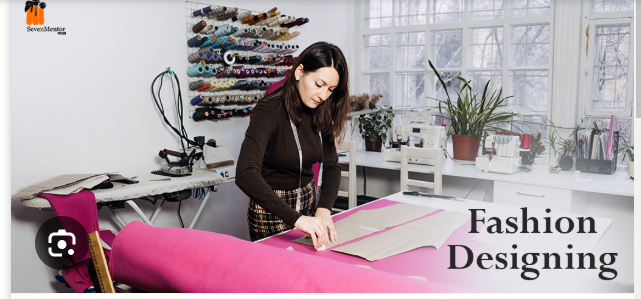
Building a successful portfolio as a beginner in fashion design is essential to showcase your skills, creativity, and potential to employers, clients, or fashion schools. Your portfolio should reflect your design process, creativity, technical ability, and unique style. Here’s a step-by-step guide on how to create a standout fashion design portfolio:
1. Understand the Purpose of a Portfolio
Your portfolio serves as a visual resume that highlights your best work and demonstrates your design ability. Whether applying for internships, freelance opportunities, or fashion schools, it’s a tool to show:
visit our website: – Fashion Designing Classes in Pune
- Your design ideas and aesthetic.
- Your technical skills in drawing, pattern making, and garment construction.
- Your ability to communicate your vision to others.
2. Choose the Right Platform
There are two main types of portfolios: physical and digital. Both have their uses, but digital portfolios are essential in today’s digital world.
Physical Portfolio:
- Use: For face-to-face interviews, events, or when presenting a collection in person.
- Presentation: Invest in a high-quality portfolio book or binder. Choose one with clean pages, and keep it well-organized.
Digital Portfolio:
- Use: For online applications, websites, or social media. It’s also easier to share and can be updated frequently.
- Platforms: Create a portfolio on a personal website using tools like Wix, Squarespace, or WordPress. You can also use platforms like Behance or Dribbble to showcase your work. Keep your website simple, clean, and easy to navigate.
3. Select the Right Work to Include
Your portfolio should showcase a range of skills, from conceptual design to technical expertise. As a beginner, include about 8-12 pieces that highlight your versatility and growth. Here’s what to include:
a) Fashion Sketches & Illustrations:
- What to Include: Hand-drawn or digital sketches of your designs, showing your creativity and understanding of garment construction.
- Why it matters: This demonstrates your ability to visualize and conceptualize designs.
- Tip: Include a variety of design styles (e.g., casual wear, evening wear, avant-garde, or streetwear).
b) Technical Drawings:
- What to Include: Flat sketches, technical drawings, and detailed representations of garments with accurate proportions.
- Why it matters: This shows your understanding of fashion construction, pattern making, and how garments come together.
- Tip: Use software like Adobe Illustrator or CorelDRAW to create digital technical drawings. If hand-drawn, ensure they are neat and precise.
c) Finished Garments/Photos of Completed Pieces:
- What to Include: High-quality images of your completed garments, either photos of real-life garments or mock-ups.
- Why it matters: Showing completed pieces adds credibility to your designs, proving you can go from concept to finished product.
- Tip: Use clear, professional photography or mock-up templates to display your pieces.
d) Mood Boards & Conceptual Designs:
- What to Include: Mood boards, color palettes, and design concepts to show how you develop and expand on initial ideas.
- Why it matters: This demonstrates your creative process and how you envision a collection.
- Tip: Present at least one full collection with a consistent theme or inspiration.
e) Patterns & Technical Skills:
- What to Include: Pattern designs, garment construction samples, or draping work if applicable.
- Why it matters: Showing your technical skills in pattern making or sewing will set you apart from other designers.
- visit our website:-Fashion designing Course in Pune
- Tip: If you’re a beginner and don’t have physical patterns to show yet, document any projects you’ve worked on and explain your process.
4. Organize Your Portfolio Effectively
Your portfolio should be well-organized to allow the viewer to follow your design journey:
- Start with a strong introduction: Include your name, a short bio, and your design philosophy or mission statement. This sets the tone for your work.
- Follow a logical order: Organize your designs by themes or collections (e.g., Spring/Summer 2024, Evening Wear, Casual Chic). Present your best work first.
- Focus on quality, not quantity: Include only your strongest and most recent work. Don’t overcrowd your portfolio with too many pieces.
5. Include Clear Descriptions for Each Piece
For each design, provide a brief description explaining the following:
- Inspiration & Concept: What inspired the design (e.g., cultural influences, nature, art, trends)?
- Fabric Choices & Materials: What materials did you use, and why did you choose them?
- Construction Process: If relevant, mention how the garment was created, including any specific techniques you used (e.g., hand-sewing, draping, digital design).
- Target Audience/Use: Who would wear this? What occasion is it suited for? This helps give context to your work.
6. Keep It Professional and Polished
Make sure your portfolio is visually appealing and professional:
- High-quality Images: Use clear, well-lit photographs or high-resolution scans of your sketches.
- Consistency in Presentation: Use a consistent layout, font, and color scheme to make the portfolio look cohesive and polished.
- Grammar and Spelling: Ensure your descriptions are well-written and free of errors. Good presentation matters.
- visit our website:- Fashion designing Training in Pune